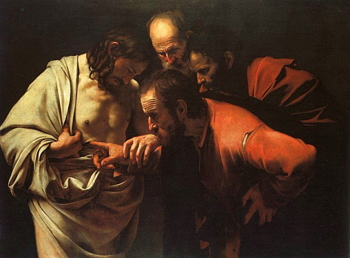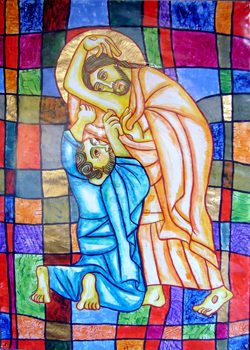For Sunday [month] [day], 2016
Lectionary Readings (Revised Common Lectionary, Year C)
Acts 5:27-32
Psalm 118:14-29
Revelation 1:4-8
John 20:19-31
The tomb is empty, Christ is risen, death has been defeated, love wins, we’re a resurrection people, the victory is ours, and nothing on earth will ever be the same again. Right? Right?
Welcome to the Week After. The week after euphoria. The week after triumph. The week after Easter lilies, egg hunts, brunches, trumpets, vigils, baptisms, and alleluias. This is the point in the liturgical year when we take a good, hard look at God’s post-resurrection world, and think, “Now what?” Or, if we’re painfully, brutally honest: “So what?”
I don’t know about you, but I am beyond grateful for the Gospel reading from St. John this week, because it reminds me that the resurrection story honors these questions. Our glorious Easter hymns notwithstanding, the Week After has always been murky, messy, and complicated. I’m not the first human being to struggle with it, and I won’t be the last. In fact, struggle seems to be intrinsic to the post-Easter story. Here are two ways that I think the Gospel reading reflects what real life looks after the empty tomb.
1) Jesus appears to his disciples in a body that is resurrected but still wounded. In my experience, Christians put a lot of stock in victory. We value the race won, the mountain scaled, the enemy defeated, the obstacle overcome. We welcome stories of failure to an extent, but only when those stories are shared in retrospect, long after the sordid worst is over. Sin that has surrendered to holiness? That's a Christian story. But sin that clings? Challenges that won't ease up? A wound — physical, psychological, or relational — that remains? We squirm. We turn our eyes away. We worry.
 |
But Jesus’s wounded body reminds me that some hurts are for keeps. Some markers of pain, loss, trauma, and horror leave traces that no amount of piety will take away. I, for example, will never become a woman who was not molested as a little girl. My teenage son will never become an adult who didn’t spend a chunk of his adolescence in chronic pain. My daughter’s body will never become one that didn’t battle anorexia. Some wounds remain, even after resurrection.
The fact is, change and growth occur slowly. I've rarely — if ever — experienced instant transformation; the changes that matter most have always come sideways and in fits and starts, often without my conscious understanding or effort. Anyone who has battled an addiction, or stuck it out in a challenging relationship, or lived with a chronic illness, will testify that genuine conversion is lifelong. Maybe this is why the earliest Christians referred to their new faith as "The Way." A "way" is not a destination. It's a road to walk. It's an invitation to journey.
Jesus' resurrected body retained its scars. Not old scars. Not neat, faded scars signaling a long-ago victory on a half-forgotten battlefield. But fresh wounds still raw enough to allow a doubting disciple to place his fingers inside. I imagine Jesus winced when Thomas touched him, but that wincing, that pain, that openness, signaled real life. Real engagement. Real presence. It spoke the very words Thomas hungered for the most: "I am here. I am here with you. I don't float a few sanitized feet above reality; even after death, I dwell in the hot, searing heart of things. Exactly where you dwell."
 |
We live in a culture that worships artifice. All around us, people package themselves, market themselves, pummel themselves into versions of perfection that choke their souls. But if Jesus, even at the apex of his resurrection victory, sported his open wounds without shame or apology, then maybe we don't need to worry so much about glossy presentation. Maybe Christianity’s best appeal is in its willingness to embrace real bodies, real scars, real pain.
After all, it is with our bodies that we experience deep trauma, deep anger, deep terror, and deep joy. It’s my chest that hurts when I mourn. It’s my face that burns when I’m angry. It’s my whole body that warms with pleasure when I’m happy. In his resurrection, Jesus honored the body. He honored the bruised, broken, wounded, and disabled body. He honored the real-life bodies in which we live.
No, our wounds aren't pretty, and no, they don't tell the whole story of who we are. But the stories they tell are holy. If Jesus himself didn't fear the bloody and the broken, then perhaps those of us walking in his footsteps don't need to fear them so much, either.
2. Thomas enters into a community of faith, but openly voices his doubts. Let’s face it: Thomas often gets a bad rap in the Church. Though his story is one of the few in the three-year cycle of the Revised Common Lectionary that never changes (we always read about his encounter with the resurrected Jesus on the Sunday after Easter), it is often cast in negative terms. He’s most famously known as “Doubting Thomas,” the cynic, the holdout. His reluctance to accept the testimony of his fellow disciples, his insistence on physical proof, his late arrival to the joyous belief of his peers— these are often described as spiritual flaws. As signs of stubbornness, or of a weak faith.
But weakness is not what I see in Thomas. I see a man who yearned for a living encounter with Jesus. A man who wouldn’t settle for someone else’s experience of resurrection, but stuck around in the hope of having his own. A man who dared to confess uncertainty in the midst of those who were certain. A man who recognized his Lord in woundedness, not glory.
| |
According to John’s Gospel, Thomas had to wait in suspense and uncertainty for a whole week after his friends first told him they’d seen Jesus. What, I wonder, did that week feel like for the disciple who missed Jesus the first time around? Did he pity his fellow disciples for their grief-stricken delusions? Or did he fear (as I so often do) that he’d missed the memo, missed the boat, missed the glory? That he was destined only ever to know God secondhand?
What strikes me most about Thomas’s story is not that he doubted, but that he did so publicly, without shame or guilt, and that his faith community allowed him to do so. And what I love about Jesus’s response is that he met Thomas right where he was, freely offering the disciple the testimony of his own wounds, his own pain. After such an encounter, I can only imagine the tenderness and urgency with which Thomas was able to repeat Christ’s words to other doubters: “Blessed are those who have not seen, and yet have believed.” Because isn’t this all of us, on the Sunday after Easter? Don’t we all wrestle with hidden doubts, hidden fears? Don’t we all wonder sometimes if the miracle of resurrection will hold in Ordinary Time?
If nothing else, Thomas reassures me that faith doesn’t have to be straightforward; the business of accepting the resurrection, of living it out, of sharing it with the world, is tough. It’s okay to waver. It’s okay to take our time. It’s okay to hope for more.
Wounds and doubts. The encounter between them is what life looks like after the tomb. When Thomas’s doubts met Jesus’s wounds, new life erupted, faith blossomed, and the community grew. Resurrection happened all over again. During this Week After, may the same be true for each of us.
Image credits: (1) LiturgyTools.net; (2) Communio; and (3) TheDailyFeast.org.





